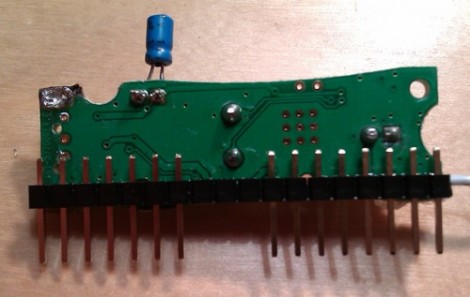
So you’ve hacked your IM-ME six ways from Sunday but don’t know what to do with the USB dongle? [Joby Taffey] set out to make this leftover a useful part of the hacking arsenal. He pulled off the USB connector and the USB controller chip. From there he glued on the pin headers as pictured above in order to turn this into a breadboard-friendly single in-line package. But wait, that’s not all… for the low-low price of common components he also built a power and programming cable. Once it’s all said and done you can load PinkOS, an operating system he developed for the device which lets you operate the onboard radio via serial protocol.
Need a better overview of the hardware on the board? [Joby] laid the groundwork for this hack back in October.















And currently Joby’s site linked there isn’t at home. It gives me an error message regarding the database. It might be overloaded with requests at the moment.
I don’t understand it. Why did they add another microcontroller to the dongle. That CC1110 radio chip has a bigger brother (the CC1111) which has a fully functional USB transceiver as well…. Cool chip by the way.
wvd2002:
Because no one at the company was aware of the big brother to the ChipCon/TI part number you’ve cited there.
Site is back online by the way.
Interesting stuff. I will be getting few of these for both normal and other uses.
The page is down for me. Also, it is not yet in the google cache, or in coral cache (nyud.net), or at the wayback machine (archive.org).
@Rob:
Indeed. Same problem as before. As for why? Perhaps his database program doesn’t scale properly under these hits?
@Rob Yes. My little rented VPS doesn’t handle being hackaday’d very well.
Here’s a coral cache link:
http://blog.hodgepig.org.nyud.net/2011/01/20/im-me-dongle-walkthrough/
At least there are google caches for the older pages.
PinkOS:
http://webcache.googleusercontent.com/search?q=cache:nnfUf4UgOygJ:blog.hodgepig.org/2010/11/30/pinkos/+http://blog.hodgepig.org/2011/01/20/im-me-dongle-walkthrough/&cd=5&hl=en&ct=clnk&gl=us
IM-Me Dongle UART:
http://webcache.googleusercontent.com/search?q=cache:GlJG1E6e00IJ:blog.hodgepig.org/2010/11/23/im-me-dongle-uart/+http://blog.hodgepig.org/2011/01/20/im-me-dongle-walkthrough/&cd=2&hl=en&ct=clnk&gl=us
I am looking forward to reading the newer pages. My ebay IM-me arrived last week. ;-)
@Joby as I mentioned previously, the coral cache link does not work for me. After you sent the link I tried again. It still does not work. If you flush your browser cache and try again you may what I see:
—–
This webpage is not available.
The webpage at http://blog.hodgepig.org.nyud.net:8080/2011/01/20/im-me-dongle-walkthrough/ might be temporarily down or it may have moved permanently to a new web address.
—–
Oh, I see that you may not have seen my previous message which is “awaiting moderation”. Apparently it was not moderate enough… ;-)
It seems that hackaday only allows a single URL in a comment, or it goes into “Your comment is awaiting moderation” status.
One useful thing I learned is that when posting a link to a youtube page, you can prevent it getting chopped off at the right by appending &w=470 to the URL, like this:
http://www.youtube.com/watch?v=vTN5IvzZOT8&w=470
@all:
Carefully!!Carefully! We must be as careful as the dwarves were with Mr. B. Baggins’s plates as with the contents of that site.
Yay! The site is up again! For now… ;-)
Back when my hackaday SD Floppy page went viral, my ISP dropped me for too much bandwidth consumption (literally thousands of hits per day, with hundreds of links to my uanr.com/sdfloppy page from all over the world, and it took days for my domain name to propagate to my IP address at the new ISP.
I hope you do not lose your ISP for this, Joby. :-)
@Rob
Now I recognize you. And oh my aching field density equalizers! I thought I recognized you when you posted the earlier one. I’ve studied that page to the point where I nearly tracked down the appropriate router just to add that style of external storage to it. (Plus the dual serial ports.) But naturally I never did.
That’s an interesting project you’ve got there, Rob, nice one.
@wvdv2002
There’s all sorts of reasons for choosing multiple chips over a single integrated solution – price, part availability, previous experience with a chip (which reduces development time and cost) etc etc.